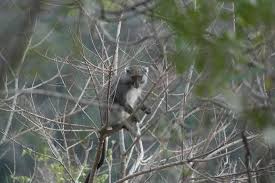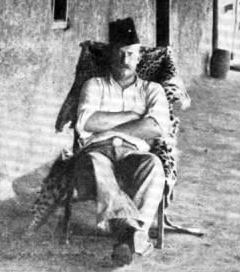Namaqualand south begins at Van Rhynsdorp and continues to the border with Namibia but I am going to start with the flowers of the West Coast National Park. The Park has Langebaan lagoon on one side and the ocean on the other. The colours are gentle mauves and yellows and white. I had a picnic there with friends just after my first hip transplant. While lying on my bed in hospital I had dreamt of baking a pork pie. I am a reasonably good home cook but had never attempted one. I got a few friends together and we picnicked beneath one of the typical round boulders in the park surrounded by flowers with the crash of breakers on the beach as music.

The pork pie was a disaster! Anyway we all had a good laugh, drank some wine and I told them of Jenny’s walk along that beach. She discarded her clothes and strode along. A droning in the sky developed into two aircraft trainers with pupil pilots from the nearby Air Force base nearly falling out of their cockpits at the sight of this gorgeous naked redhead. They waggled their wings and Jen happily waved back!
We were seated near the site of Eve’s footprints. In 1995 David Roberts from the Museum in Cape Town was searching for fossils when he came across the prints on a sand dune made during a turbulent rainstorm. They were of a female during the time of emergence of homo sapiens and the use of stone tools. She was 1,5 m tall and her feet were the same size of modern women.
Eve, given the name by the media, lived about 5 million years ago. At the time the climate was warmer with higher rainfall and tropical vegetation. Eve must have been very wary for the animals that lived at the same time were Agriotherium Afrricanum, a huge bear and the only one found south of the Sahara, a sabre toothed tiger, a three toed horse and gomphothere Anacus, a type of elephant that later became extinct.

The country varies, but is barren and desolate as you leave Clanwilliam with its huge dam and the Cedarberg mountains beyond, the road stretching ever upwards towards Namibia.
On to proper Namaqualand beginning at Vredendal and the town of Van Rhynsdorp that sits on the edge of the Knersvlakte (gnashing plain) that reflects the sound the early wagons made as they crossed the flats on quartz stones. Van Rhyn’s pass rears up at the edge of the flats some 549 metres onto the Bokkeveld Range (Goat or antelope field) to Niewoudtville with its lovely sandstone buildings. Vast meadows of Yellow bulbinella flowers thrive here on the lonely farms.
A farmer told me that one year he put his weaned lambs into a camp and was devastated when they all died. A friend told him to leave an old ewe with them the next year. He did so and the old lady taught them which plants they could eat and which were poison!
MacGregor is the family name of a few of the farmers here. My friend who shall be nameless met one and invited him to visit her in Cape Town. MacGregor arrived with a huge leg of mutton under his arm, unaware that she was married. She told him to come to me and hastily shut her door. Now I had a gentleman friend who was visiting, a conservative fellow who was aghast when MacGregor arrived with the leg. “You can’t possibly have this stranger in your home for the night!” “Of course, he comes from my friend!” He left, Macgregor stayed, left the next day with the large leg in my freezer.
We would often go down to Langebaan lagoon for weekends staying in little thatched cottages at Churchaven belonging to the Barsby family. The families of Curchaven and Stofbergsfontein arrived in the 1800-1900’s. They were independent folk with a code of modesty, self reliance and care for the environment. They built their homes themselves from local materials, a one roomed school house and a church. The farms were owned collectively.
One weekend Tony Millard and some other friends came too and we put the leg into a large black pot and simmered it on the fire for hours and hours. It was superb! Tony decided he wanted a bath and as there was no bathroom, just a long drop toilet, he climbed into an aluminum tub with someone offering to scrub his back. I have lost the pic but Tony is now a very successful racehorse trainer in Hong Kong.
Van Rhynsdorp is named after Petrus van Rhyn the first member for Namaqualand in the old Cape Legislative Council and a leading public figure in the district. There is a delightful little museum that has a sepia portrait of Manie Maritz, the Boer commando, a really good looking guy. As my grandmother would say, he could have put his boots under my bed! Also in van Rhynsdorp is a succulent nursery here that has a story behind it. The owner of the land was a bodyguard to General Jan Smuts who was Prime Minister of South Africa and lived in Pretoria.
The tale goes that a certain gentleman who was body guard to General Jan smuts when he was Prime Minister of South Africa used to accompany the ‘Ou Baas (Old Boss) as he was affectionately called, learnt much of botany from this remarkable man. Retiring back to Van Rhynsdorp he wondered how he was going to earn a living in this harsh environment. He hit on the idea of starting a succulent nursery. It was a success and is still there today.
At the top of the pass, one of the 10 most impressive in the Northern Cape, built by Thomas Bain, is the Oorlogskloof (War Valley) Nature Reserve and here one can see the Gymnogene raptor soaring above the escarpment. This bird is a species on its own, grey with a yellow bill and easily seen here. The Nature reserve is home to many small mammals and rare species of flora.

Back to the Knersvlakte, the name meaning gnashing plains because as the old wagons crossed it they made a crunching noise trundling over the harsh quartz stones. The Knersvlakte is home to succulents of all kinds and during the flower season it is festooned with bright orange and red and purple.
Northwards to Bitterfontein (Bitter fountain) one passes an odd sign Douse the Glim, a farm. The name is attributed to a tired surveyor who irritably told his servant to douse the glim, meaning turn off the light.
Here I came across another story about Jan Smuts. I found a farm that offered accommodation near Bitterfontein and noticed that there were ruins of an old farmhouse. I asked my host about it and he told me the story. His forefather was building a homestead. He had only the roof to complete and the corrugated iron sheets lay waiting.
During the first world war Smuts served with distinction in German East Africa. The British government asked him to invade German South West Africa and it was when his column was en route to German South West Africa that he came across this farm. Smuts arrived with his column of men, horses and cattle on his way to German South West Africa now Namibia. He commandeered the roofing to make mangers for the animals and the poor farmer had to save up again for another roof!
Manie Maritz was commandant of the north column and together the two executed a successful annexation of German South West Africa, claiming the capital Windhoek. South Africa was given occupation of the territory.
In 1933 Smuts was deputy Prime Minister and served with Churchill during the second world war. He was instrumental in forming the League of Nations that became the United Nations. I remember him well and how he used to walk up Skeleton Gorge on Table Mountain every morning before breakfast. In 1947 the Royal Family arrived in the battleship, Vanguard and stayed in Cape Town. The Vanguard was used as the Royal Yacht. She had an illustrious name after her sister that had fought in the battle of Armade and Jutland. Princess Margaret was a good mimic and I had it on good authority from my mother’s cousin’s husband who was their chauffeur that she often mimicked General Smuts and other dignitaries.
Onwards on our journey to Kamieskroon and the Skilpad reserve where fields of flowers emerge each spring when the winter rains are good. The name comes from the Kamiesberg range one mountain of which dominates Kamieskroon with a large boulder perched at its peak aptly named the crown. This reserve is magic and one year it was covered in scarlet bulbinella. I felt like sitting down in the middle of it with a bottle of champagne!
Jan van Riebeek arrived at the Cape in 1652 to start a garden to service the Dutch East India company ships on their way to the East. He dispatched Simon van der Stel to the northwest searching for the legendary city of Monomatapa. Van der Stel’s wagons were attacked by a rhino at Piketberg! He made frequent sorties and finally arrived in what was to become Springbok. He was told of copper by the locals and eventually found the metal in 1682 at Copper Mountain or Carolsberg today part of the Goegap Nature Reserve in Springbok.
The yield at Carolsberg was poor and more deposits were found by Hendrik Hop in 1761 near the Orange River. Extraction was a problem and it was only in 1836 that James Alexander found rich deposits on the banks of the river. The first Copper Mining Company started working the copper in 1846. A German called von Schlicht found a huge deposit but could not get investors. Von Schlicht had a housemate, Mr. Jencken who found a company called Phillips & King that purchased the land in 1850 together with the mineral rights. They called the farm Springbokfontein and started the commercial exploitation of the copper.
The farm became a village, the village a town and was finally registered as Springbok. Springbok grew under copper mania until a new treasure was found. Fred Cornell was the first to suspect the presence of diamonds but his efforts were unsuccessful. Jack Carstens was the first person to prove the existence of these gems in 1925 and opened a little diamond industry at Kleinsee.
Merensky searched north of Port Nolloth and found diamonds south of Alexander Bay. Today we know that the diamonds were carried from Antartica northwards by the Benguela current that originates there. In 1908 there was a diamond rush and the area was proclaimed a Sperregebiet, prohibited area. It still exists although De Beers Diamond Mining has left Kleinsee now. My daughter Susan lives there and since De Beers left Nama people have claimed the land and are digging for diamonds! I can’t wait to get there to be able to tell you the story.
In my next instalment when I return I will tell you of the journey from Springbok to Kleinsee over a pass that is not called the Spectakel





